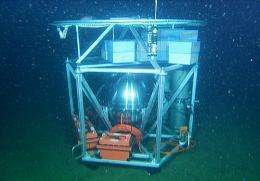First sea trials for deep-ocean robotic DNA lab

(PhysOrg.com) -- In late April 2009, a team of MBARI researchers tested the world's only deep-sea robotic DNA lab beneath the waters of Monterey Bay.
This instrument is the latest version of the Environmental Sample Processor (ESP), which MBARI molecular biologist Chris Scholin has been developing for over 10 years. The ESP is a self-contained robotic laboratory that collects samples of seawater and tests these samples for different types of genetic material, such as DNA.
Over the last several years, Scholin and his team have used the ESP to study microscopic marine life near the sea surface in Monterey Bay. However, adapting the ESP to work in deep water added new challenges to what was already a very complicated project. Because of the immense pressure in the deep sea, the researchers had to build a special pressure housing to protect the delicate instrument. They also had to design and build an automated system to "depressurize" seawater before it could be introduced into the ESP.
Scholin's team spent the last two years designing and building these systems and integrating them with the ESP. On April 23, they tested the completed system in the open ocean for the first time. On May 1, they ran the first water sample through the system, looking for genetic material from marine bacteria. Both tests were successful.
Later this spring, the deep-ESP team will test the instrument for several days in water about 2,900 meters deep, offshore of Monterey Bay. In August, 2009, the deep ESP will be deployed for its first scientific mission—to study microorganisms near hydrothermal vents off the coast of Oregon. Later in 2009 it will be hooked up to the MARS undersea observatory, which will allow the team to run experiments and gather data from shore.
The deep-ESP project was funded by grants from the National Science Foundation, the Keck Foundation, NASA, the Gordon and Betty Moore Foundation, and the David and Lucile Packard Foundation.
Provided by MBARI



















